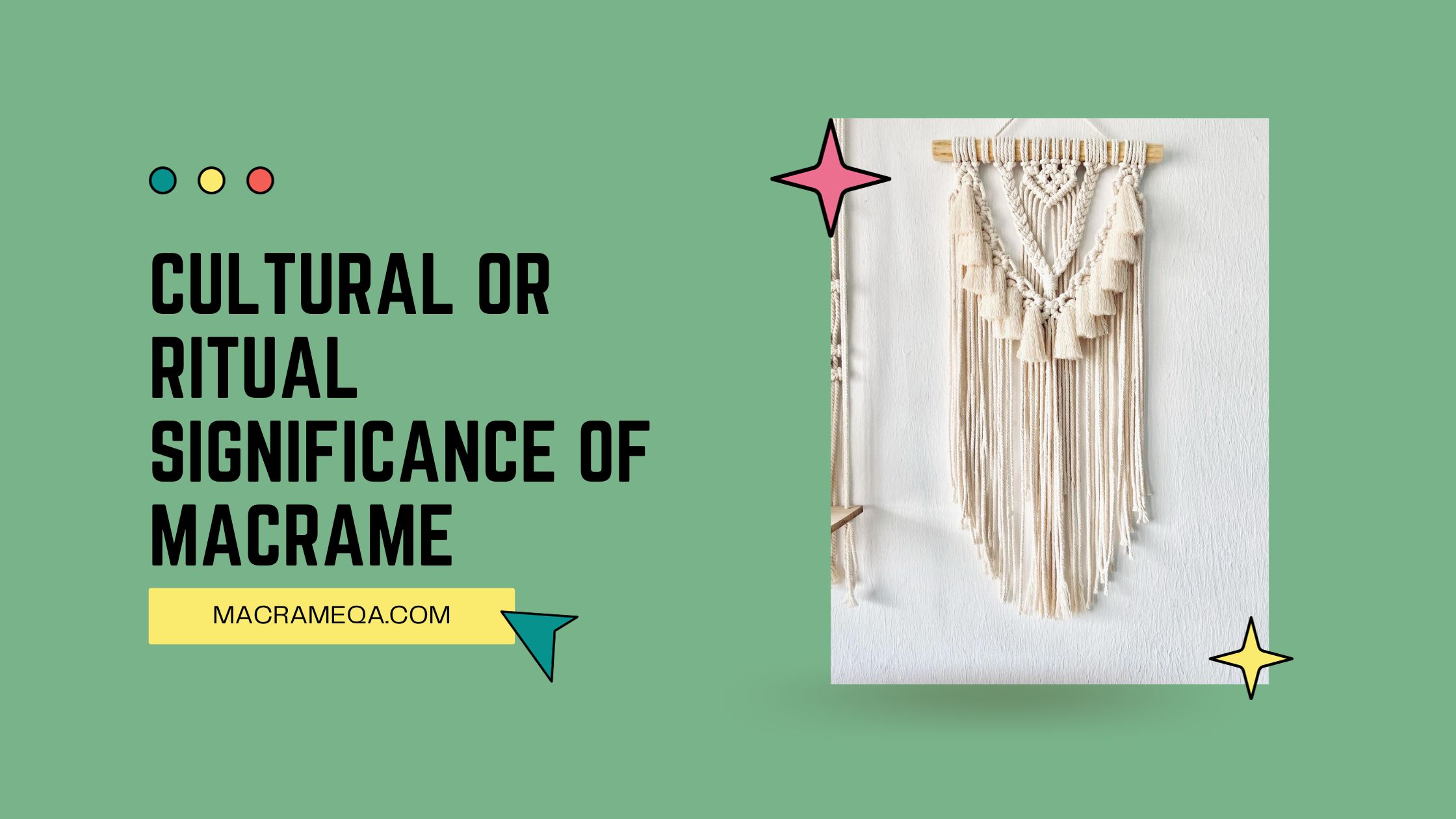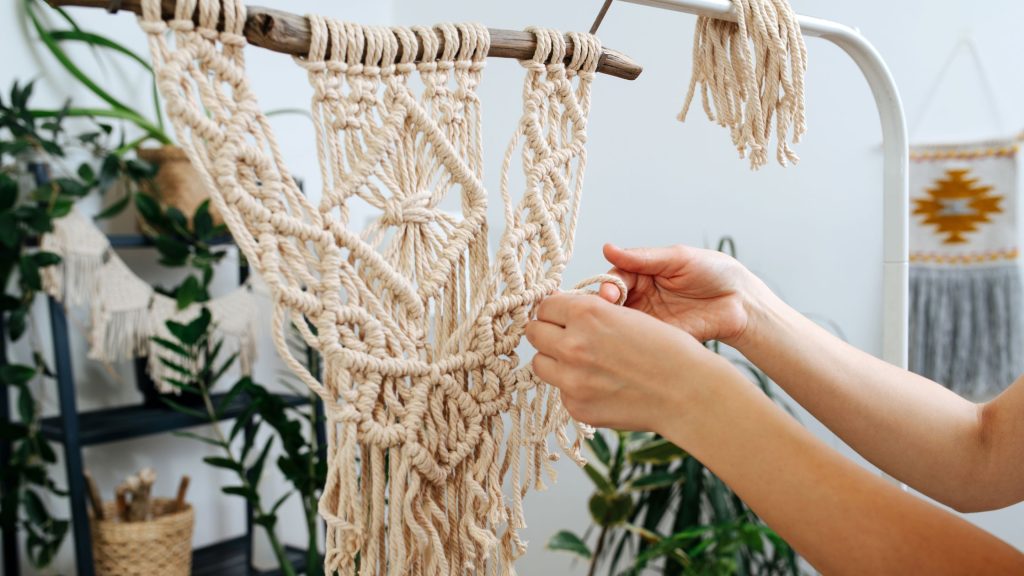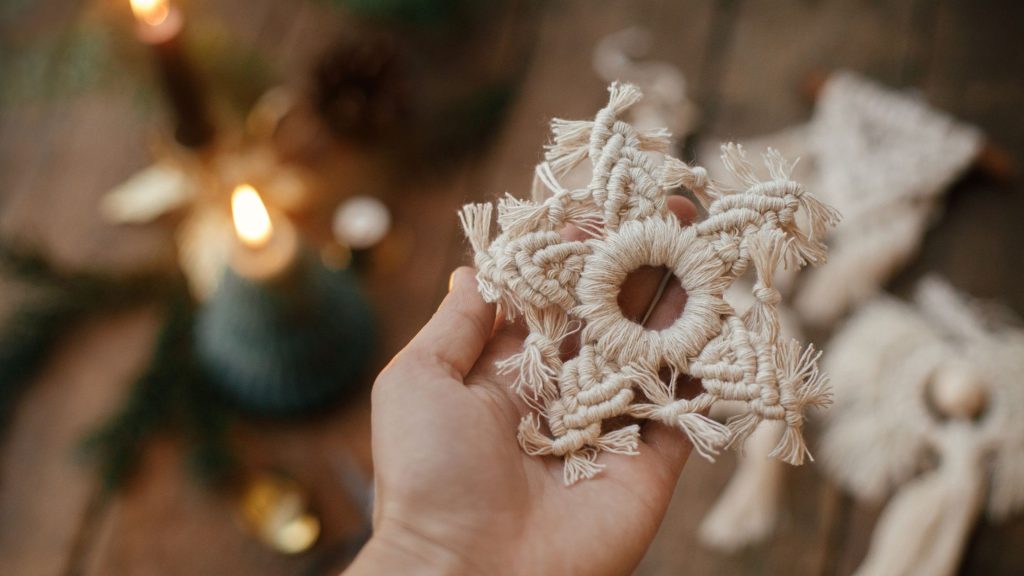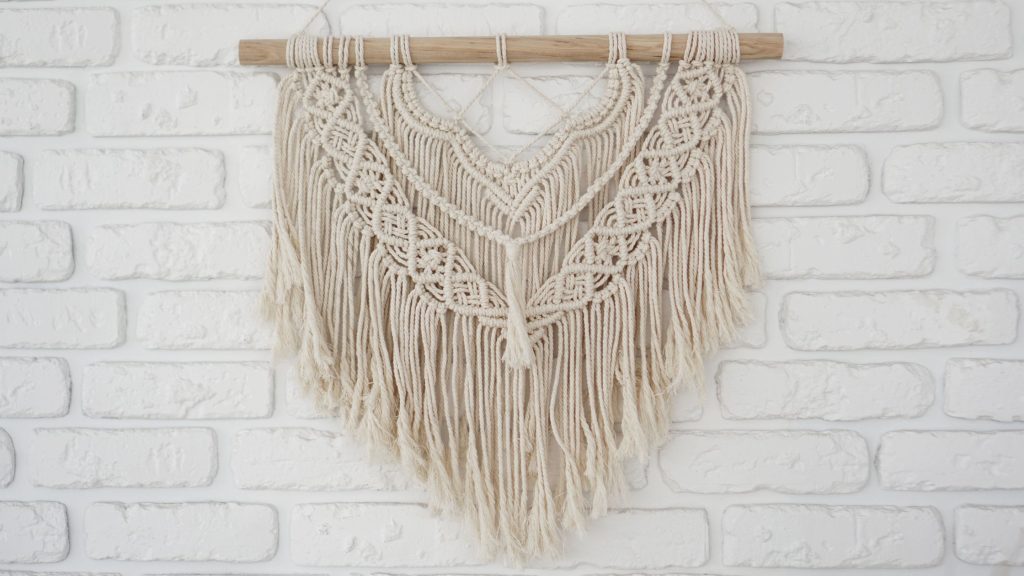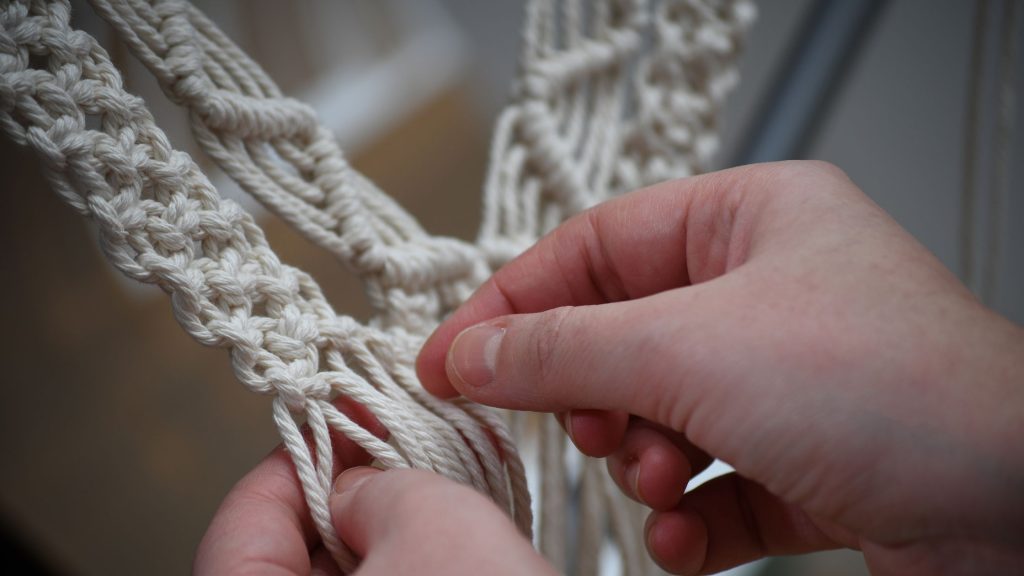Macrame, the art of knotting threads into intricate designs, has a rich history that stretches back centuries. But amidst the mesmerizing patterns and delicate creations, one question remains: did macrame have any cultural or ritual significance? As you delve into the origins of this ancient craft and explore its presence in various cultures, you’ll uncover a tapestry of traditions and beliefs intertwined within each knot. From spiritual rituals to practical uses, the story of macrame goes beyond aesthetics, offering a deeper understanding of its cultural tapestry.
History of Macrame
Origins of Macrame
Macrame, the art of knotting cord or thread to create decorative and functional designs, has a rich history dating back thousands of years. While its exact origins are unclear, it is believed to have emerged in ancient civilizations such as the Babylonians and Assyrians. These early forms of macrame were used to create simple yet intricate patterns for practical purposes such as securing clothing and making fishing nets.
Spread of Macrame
As civilizations expanded and traded with one another, macrame techniques began to spread across different regions. The Phoenicians and Egyptians adopted and further developed macrame, incorporating beads and shells into their designs. With the rise of the Roman Empire, macrame reached Europe and was embraced as an art form by the Celts and Vikings, who used it to embellish their clothing and accessories.
Traditional Uses of Macrame
Throughout history, macrame has served various traditional purposes in different cultures. In China and Japan, macrame was used to create intricate knotwork for decorative purposes, while in Central America, the indigenous populations utilized macrame to produce hammocks, belts, and other functional items. Macrame also played a significant role in maritime cultures, as sailors would craft intricate knots to pass the time at sea and to create sturdy tools, such as bags and belts, for their journeys.
Cultural Significance of Macrame
Macrame as a Form of Art
Macrame has long been recognized as more than just a craft; it is a true art form. Its intricate knotting techniques and complex designs showcase the creativity and skill of the artisans who create these pieces. From wall hangings to plant hangers, macrame allows artists to express their unique vision and bring beauty and texture to any space.
Macrame Techniques in Different Cultures
Different cultures have developed their distinct macrame techniques over the centuries. In China, the art of Chinese macrame, also known as “knot art,” involves the use of intricate knots and the incorporation of traditional Chinese symbols and motifs. In contrast, Middle Eastern macrame, often referred to as “Arabic knotted lace,” focuses on the use of intricate patterns and designs in creating jewelry and home decor items.
Symbolism in Macrame Designs
Macrame designs often hold symbolism and meaning in various cultures. In some Native American tribes, macrame patterns were believed to have protective or healing powers. In Buddhist cultures, certain macrame designs represent spiritual blessings and enlightenment. Additionally, the use of gemstones or crystals within macrame pieces can add layers of symbolism and energy to the design.
Macrame as a Decorative Element
Macrame has been utilized to enhance the aesthetic appeal of various spaces and events. Whether it is a beautifully crafted macrame wall hanging adorning a living room or an intricately knotted macrame backdrop for a wedding ceremony, macrame adds a touch of elegance and uniqueness to any setting. Its versatility allows it to be incorporated into different interior design styles, ranging from bohemian to minimalist.
Macrame in Rituals and Ceremonies
Macrame in Wedding Ceremonies
Macrame has become increasingly popular in wedding ceremonies as a way to create a romantic and bohemian atmosphere. Macrame backdrops and arches provide a visually stunning focal point for exchanging vows, while macrame table runners and chair decorations add a touch of whimsy to the reception. The intricate knots and delicate details of macrame symbolize the strength and beauty of the union between two individuals.
Macrame in Birth Rituals
In some cultures, macrame is incorporated into birth rituals as a symbol of protection and good fortune for the newborn and mother. Macrame wall hangings featuring protective symbols or knots are often hung in the birthing space to create a serene and positive environment. Additionally, macrame baby carriers and mobiles are crafted to welcome the newborn into the world and provide a sense of comfort and security.
Macrame in Spiritual Practices
Macrame has deep spiritual significance and is often used in various spiritual practices. Buddhist monks, for example, create intricate macrame knots as a form of meditation and mindfulness. The repetitive knotting process allows them to focus their minds and connect with their spiritual beliefs. Similarly, shamans and healers from indigenous cultures incorporate macrame into their rituals to create sacred spaces and enhance their connection with the spiritual realm.
Macrame in Healing and Meditation
Macrame also plays a role in healing and meditation practices. The process of knotting and creating intricate designs can be inherently therapeutic and calming. Macrame meditation mats and wall hangings, often adorned with healing crystals or gemstones, serve as focal points for relaxation and spiritual connection. The texture and energy of the macrame pieces enhance the overall experience of healing and meditation.
Macrame in Tribal Rituals
Throughout history, macrame has been used in tribal rituals as a symbol of identity and cultural heritage. Indigenous tribes around the world incorporate macrame into their traditional ceremonies, such as coming-of-age rituals or harvest celebrations. The intricate patterns and symbolism of macrame are seen as representations of their connection with nature, ancestors, and spirituality.
Macrame in Indigenous Cultures
Macrame as a Cultural Heritage
In many indigenous cultures, macrame is a craft and an essential part of their cultural heritage. The techniques, patterns, and designs are passed down through generations, ensuring that the art form continues to thrive. Macrame pieces carry the stories and traditions of the community, serving as tangible symbols of cultural identity and pride.
Macrame in Native American Culture
Native American tribes have a long history of macrame, often using it in ceremonies and rituals. Macrame was incorporated into clothing, accessories, and regalia, reflecting the identity and spirituality of the tribe. Each knot and design held significant meaning, with patterns representing tribal symbols, stories, and connection to the natural world.
Macrame in African Culture
Macrame has deep roots in African culture, with various tribes developing their own unique techniques and designs. In West Africa, macrame was used to create intricate jewelry, such as the popular technique of micro-macrame. Meanwhile, in North and East Africa, macrame was utilized in traditional garment decoration and home decor, showcasing the vibrancy and diversity of African artistry.
Macrame in Indigenous Australian Culture
Indigenous Australian cultures have long embraced macrame as a way to express their connection to the land and spirituality. Macrame techniques and designs are integrated into the creation of jewelry, belts, and ceremonial pieces. These intricate macrame creations often incorporate natural elements like feathers and shells, representing the deep reverence for the environment and ancestral wisdom.
Modern Significance of Macrame
Macrame in Contemporary Art
Macrame has experienced a resurgence in contemporary art, with artists pushing the boundaries of traditional techniques and exploring new ways to incorporate macrame into their creations. From large-scale installations to mixed media sculptures, macrame is now a versatile medium for artists to express their artistic visions. The combination of traditional knotting techniques with modern concepts has breathed new life into the art form.
Macrame as a Popular Craft
In recent years, macrame has gained popularity as a craft that allows individuals to express their creativity and create unique handmade pieces. From plant hangers to wall hangings, macrame has become a popular choice for DIY enthusiasts. Macrame kits and tutorials are readily available, making it accessible to people of all skill levels and adding a personal touch to their homes or gifts.
Macrame in Fashion and Home Decor
Macrame has made a strong comeback in the world of fashion and home decor. Designers and brands are incorporating macrame elements into their clothing and accessory lines, ranging from intricate macrame details on dresses to macrame handbags and earrings. In-home decor, macrame wall hangings, curtains, and plant hangers provide a bohemian and cozy touch to any space, capturing the essence of modern interior design trends.
Macrame and Sustainable Living
As the world shifts towards sustainable living, macrame has gained recognition for being an eco-friendly craft. The materials used in macrame, such as natural fibers like cotton and hemp, are biodegradable and renewable. Additionally, the handmade nature of macrame promotes slow and mindful consumption, encouraging individuals to appreciate the artistry and value of handcrafted items over mass-produced alternatives.
Revival of Macrame
Macrame’s Resurgence in the 1960s and 1970s
The 1960s and 1970s marked a period of cultural revolution and artistic exploration, and macrame experienced a significant revival during this time. The hippie movement embraced macrame as a symbol of counterculture and individuality. Macrame plant hangers, wall hangings, and clothing became iconic symbols of the era, reflecting the free-spirited and bohemian lifestyle that defined the time.
Macrame in the DIY Movement
The rise of the do-it-yourself (DIY) movement in recent decades has further propelled the popularity of macrame. The accessibility of online tutorials, workshops, and community platforms has empowered individuals to learn macrame techniques and create their unique pieces. Macrame has become a way for people to express their creativity, reduce stress, and connect with a supportive community of fellow crafters.
Macrame in Modern Interior Design
With the resurgence of bohemian and eclectic interior design styles, macrame has become a staple element in modern homes. Macrame wall hangings, plant hangers, and curtains add texture, warmth, and a touch of nostalgia to contemporary living spaces. Macrame also provides an opportunity for individuals to personalize their homes, showcasing their creativity and unique style.
Macrame in Different Regions
Macrame in Europe
Europe has a rich history of macrame, with various countries contributing unique styles and techniques. Countries such as Spain and Italy have a long tradition of producing macrame lace, characterized by delicate and intricate knotwork. Scandinavian macrame, on the other hand, emphasizes simplicity and minimalism, focusing on clean lines and geometric patterns.
Macrame in Asia
Asia has a diverse range of macrame traditions, each with its unique characteristics. Chinese macrame, also known as “knot art,” blends intricate knotting techniques with traditional Chinese symbols and motifs. In Japan, the art of macrame, known as “kumihimo,” is renowned for its use of braiding, creating intricate patterns and designs in cords and threads.
Macrame in the Americas
Macrame has a strong presence in the Americas, particularly in Central and South America. Indigenous populations have passed down macrame techniques for generations, creating stunning hammocks, belts, and decorative items. Macrame also became popular during the macrame craze of the 1960s and 1970s in the United States, where it was embraced as a symbol of self-expression and creativity.
Macrame in Africa
Africa boasts a rich variety of macrame traditions, each reflecting the cultural diversity of the continent. West African macrame is characterized by intricate knotting techniques and the incorporation of beads and shells into jewelry and accessories. North African macrame, influenced by Arabic design, features complex patterns and geometric motifs in home decor and clothing.
Macrame in Oceania
Oceania is home to vibrant macrame traditions, particularly in the indigenous cultures of Australia and Polynesia. Indigenous Australian macrame incorporates natural elements like feathers and shells, creating intricate jewelry and ceremonial pieces. In Polynesia, macrame techniques are used to craft decorative items, such as grass skirts and wall hangings, reflecting the rich tapestry of Pacific island cultures.
Macrame as a Craft and Hobby
Macrame: From Functional to Decorative
While macrame has traditionally served functional purposes like creating fishing nets and securing clothing, it has evolved into a popular decorative craft. People of all ages and skill levels have embraced macrame as a hobby, creating intricate wall hangings, plant hangers, and jewelry. The transition from functional to decorative has allowed macrame to be appreciated not only for its practicality but also for its artistic value.
Macrame as a Therapeutic Activity
Engaging in macrame can be a therapeutic and meditative activity. The rhythmic process of knotting and creating intricate designs can promote relaxation, mindfulness, and a sense of accomplishment. Macrame provides an opportunity to focus the mind, relieve stress, and enhance overall well-being. As a result, many individuals turn to macrame as a form of self-care and creative expression.
Macrame Community and Workshops
The popularity of macrame has led to the formation of vibrant online and local communities of macrame enthusiasts. These communities provide a platform for individuals to connect, share their creations, and seek inspiration. Macrame workshops and classes are also readily available, offering hands-on learning experiences and the opportunity to learn from experienced artists and instructors.
Macrame Learning Resources
Learning macrame has become increasingly accessible with abundant online tutorials, books, and video lessons. Aspiring macrame artists can find a multitude of resources to guide them through the process of learning knotting techniques, pattern creation, and project execution. These resources enable individuals to develop their skills and creativity at their own pace, fostering a sense of independence and empowerment.
Macrame for Social and Economic Empowerment
Macrame Cooperatives and Fair Trade
Macrame has been instrumental in creating avenues for social and economic empowerment, particularly within marginalized communities. Macrame cooperatives and fair trade initiatives provide a means for artisans to earn a sustainable income. By supporting these initiatives, consumers can contribute to the preservation of traditional craft techniques and promote ethical practices within the macrame industry.
Macrame in Women’s Empowerment
Macrame has played a significant role in empowering women around the world. Many macrame cooperatives and businesses focus on providing opportunities for women to develop their skills, gain financial independence, and support their families. By engaging in macrame, women can break free from gender-based limitations, showcase their talent, and contribute to their communities.
Macrame Entrepreneurship
Macrame offers entrepreneurial opportunities for individuals passionate about the craft. Starting a macrame business allows artists to showcase their creativity, connect with customers, and establish a sustainable source of income. Whether it is selling handmade macrame items online or teaching macrame workshops, entrepreneurship in the macrame industry provides individuals with the freedom to pursue their passion and build a fulfilling career.
Conclusion
Macrame’s journey has been one of cultural, artistic, and economic significance. From its ancient origins to its modern-day resurgence, macrame has captivated people across time and continents. Its cultural significance, symbolism, and versatility make it a cherished art form and craft. Whether as a form of self-expression, a platform for cultural preservation, or a means of economic empowerment, macrame continues to weave its way into the fabric of our lives, reflecting our individuality, creativity, and connection to our heritage.

